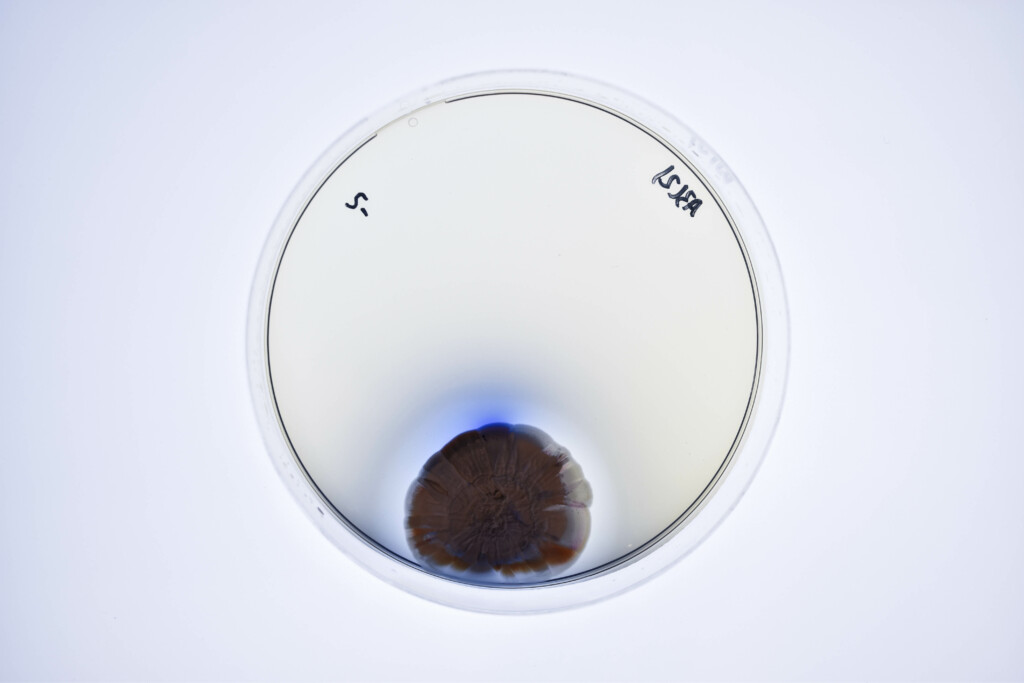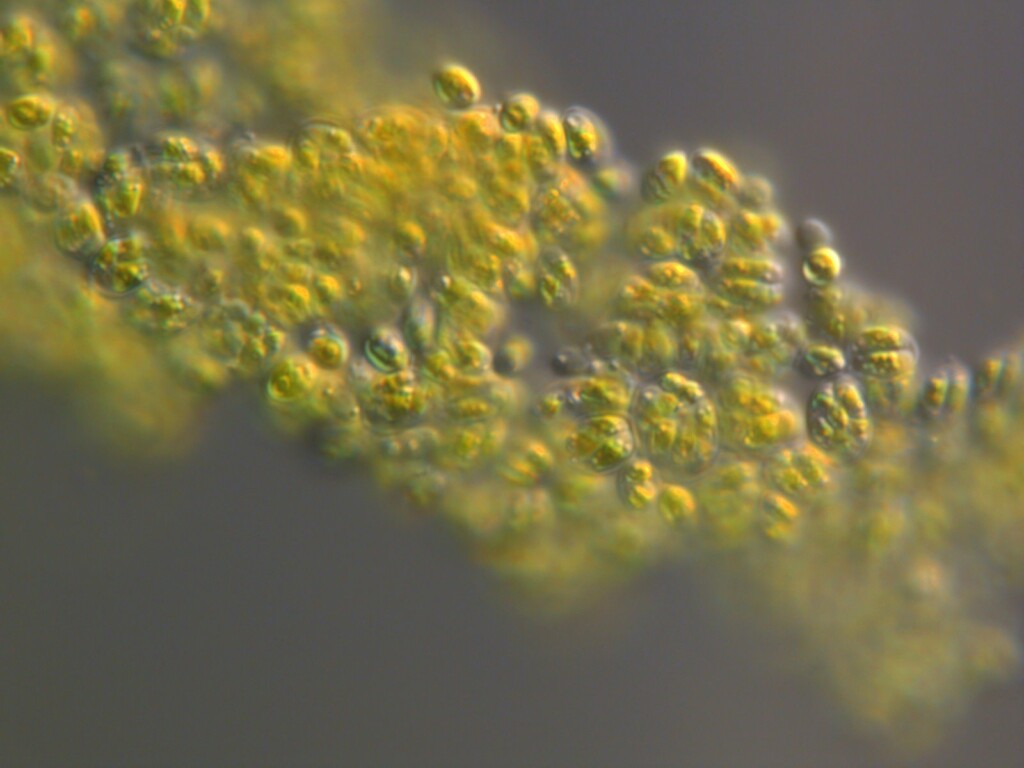- Algae
- Algae, primarily found in aquatic settings, generate 70% of Earth's oxygen and are key to food chains and nutrient cycling. Beyond their ecological importance, they have various industrial uses such as producing proteins and pharmaceuticals. They are vital for sustaining life on Earth.
- Bacteria
- Bacteria, ancient and resilient, are ecosystem linchpins, aiding nutrient cycling and life's equilibrium. With an astonishing mass of up to 200 billion metric tons, they intrigue scientists, advancing fields like medicine and ecology. These unseen microorganisms are integral, yet fascinating, players in Earth's biodiversity.
- Biodesign
- Biodesign incorporates living processes and biological principles into design at various levels of impact. It extends beyond biomimicry, recognising the potential for sustainable building and manufacturing with organic materials. This approach has fostered collaborations between scientists, artists, designers, policymakers, and more, reimagining creation, production, and consumption from an ecosystem-centred viewpoint.
- Bioeconomy
- An economic sector that leverages bioscience to reduce fossil fuel dependency and enable a transition towards sustainable economic practices by harnessing renewable biological resources. Currently, approximately 50 countries are actively developing national strategies for bioeconomy, investing in innovations to drive progress in this field.
- Biomaterial/Bio-based Material
- A general term used to describe materials, whether naturally occurring in nature or human-made, derived from or produced by biomass, such as animals, plants, and other life forms. A branch of a new generation of biomaterials is grown by living cells and microorganisms—bacteria, fungi, and algae—through the processes of fermentation, culturing, and engineering. Examples include spider silk, microbial pigment, mycelium leather, bacterial cellulose.
- Biomanufacturing
- A process of manufacturing bio-based products at commercial scale. Biomanufacturing uses both wildtype and engineered biological organisms, with applications ranging from detergents, food and biomaterials.
- Biomimicry
- A practice that learns from and mimics biological processes to translate those strategies into sustainable products, processes or policies. It honours nature’s wisdom, modelling solutions based on holistic observations of living systems and setting planet-centric standards for human innovations. According to the Biomimicry Institute, biomimetic approach to design has a healing quality for humanity, as it allows us to reconnect with life, rather than extract or dominate it.
- Biophilic Culture
- A human culture capable of re-connecting with nature towards more harmonious coexistence. From values to relationships, objects, and systems, its foundations are based on circular and restorative flows between people and the Biosphere, towards planetary health. As such, humans are seen as biological beings integral to the natural world rather than separate from it, with recognised impact and a sense of agency in its wellbeing.
- Biosphere
- The Earth layer where life can exist and thrive. The biosphere consists of abiotic (non-living) factors, living organisms (biota), and energy. It measures about 20 km, extending from the deep-sea surface to a few kilometres above sea level. It has existed for about 3.5 billion years, initially being occupied by single-celled prokaryotes, bacteria and archaea, which were able to survive without oxygen and transform the environmental conditions for other organisms to thrive, thanks to the process of photosynthesis.
- Circular Design
- An approach to design that rejects a linear intervention and instead centres on waste-free circulation of materials and resources. It presumes that climate change and biodiversity loss exist by design; therefore, the elimination of waste and resources should be inherent to the design process to make the economy work for both people and the planet. In a traditional linear approach, materials and resources are produced, used, and disposed of. The circular path rethinks the whole lifecycle of objects, in which, at the end of their life, materials are recovered and reused.
- Co-design
- An approach to design that positions end-users as experts in their own context. It is a kind of collaboration, where the intent is to create something that is not known in advance by means of collective creativity throughout the design process.
- Cradle to Cradle
- "Cradle to Cradle" is a sustainability concept focused on designing products and systems that are safe, ecologically designed, and fully recyclable or compostable throughout their entire lifecycle. It promotes a circular economy where materials are reused, minimising waste and environmental impact.
- Cradle to Gate
- A model for lifecycle analysis that measures the impact of a material or a product from resource extraction to the point of the product leaving the factory gates and before being transported to the user.
- Ecosystem
- Ecosystems are complex networks of interconnected relationships among living beings and their environments, spanning diverse habitats and human developments. They represent a dynamic interplay between ecology, society, and culture, emphasizing the mutual impact between human practices and ecosystem resilience.
- Enzyme
- Enzymes are specialised biological molecules found in various living organisms, including plants, animals and microorganisms, where they regulate and facilitate a wide range of metabolic processes for the functioning of all living systems. By identifying and isolating specific enzymes from diverse sources, humans use them as natural catalysts in producing food, pharmaceuticals, materials and more.
- Feedstock
- In biotechnology, feedstocks are the raw materials used as the foundation for biological processes, such as fermentation. These materials serve as a source of energy and nutrients for microorganisms or cells to produce various valuable bioproducts. The choice of feedstock in biotechnology processes is essential for optimising production and ensuring the economic and environmental sustainability of bioprocesses.
- Fermentation
- Fermentation is a naturally occurring process where microorganisms break down sugars into simpler substances like acids, alcohol and gases. Humans have applied their knowledge of this phenomenon to transform fermentation into a biotechnological tool to produce diverse products like alcoholic beverages, cheese, pharmaceuticals, and even materials.
- Fungi
- Fungi are diverse eukaryotic organisms with essential ecological roles as decomposers and forming mutualistic relationships with plants and animals. Humans and fungi have co-evolved, leading to their use in food, medicine, and biotechnology. Fungi contribute to fermentation, enzyme production, antibiotics, and biomaterials like mycelium-based composites. Their potential in regenerative systems and human health is being increasingly recognised.
- GMO (Genetically Modified Organism)
- An organism whose genome has been altered by direct manipulation using genetic engineering. Unlike selective breeding, GMOs do not rely on naturally occuring genetic diversity to create new traits. GMOs may be used for a variety of purposes, such as medicine and vaccine production, fermented beverages, and disease- and pest-resistant crop plants.
- Impact
- A marked positive effect of business activity on social, economic and environmental health.
- Living System
- A living system is a complex, organised collection of living organisms or components that interact with each other and their environment. These systems display characteristics of life like growth, reproduction, and metabolism and can range from individual cells to entire ecosystems. Living systems are interconnected, self-regulating, and adaptable, existing at various levels of biological organisation.
- Microorganism
- Invisible to the naked eye, microorganisms are single-celled or multicellular organisms that regulate various aspects of living systems. This diverse and ubiquitous group includes bacteria, protozoa, algae, fungi, and yeast and is found in water, soil, air, and within other organisms. Depending on the microorganism, they can be beneficial or cause harm to an ecosystem or an organism, but also aid processes like fermentation and metabolic process like digestion. Microorganisms offer versatility and affordances to biomanufacturing, underpinning various industries, from pharmaceuticals to biodesign.
- Mycelium
- Mycelium is the root-like structure of fungi and is made of hyphae networks that support the reproductive cycle of fungi and collect nutrients for their growth. It contributes to soil health and therefore entire ecosystems, producing enzymes that decay organic matter into compounds that nourish the fungi and their symbiotic partners. In industry, mycelium is grown into biodegradable materials and products for textiles, building components and even meat alternatives.
- Planetary Boundaries
- Defined in 2009 by researchers at the Stockholm Resilience Centre, these are nine quantitative limits to human activity that threaten the stability of Earth systems: climate change, biodiversity integrity, ocean acidification, depletion of the ozone layer, atmospheric aerosol pollution, biogeochemical flows of nitrogen and phosphorus, freshwater use, land-system change, and release of novel chemicals.
- Regenerative
- Tending to restore or regrow values, resources and relationships in a holistic manner towards planetary wellbeing.
- Scale-to-fit
- A planet-centric business growth measure that takes a holistic view of both internal and external factors, such as capacity, goals and context, to assess the potential and feasibility of its sustainable growth.
- Scale-up
- A business growth measure that focuses on increasing the capacity of current resources or operations to grow in size and profitability within the same market. It is considered a standard measure that defines the next milestones and proves the company’s viability.
- Supply Chain
- A network of individuals, organisations, activities, information and resources that contribute to the creation and movement of an end product, from its origination in the raw materials to the end-of-life resource management. The health and resilience of the supply chain is constitutive to the functionality of a business and depends as much on the robust operational flows as on cooperative relationships between all stakeholders.
- Synthetic Biology
- Synthetic biology is an interdisciplinary field of science and engineering that focuses on designing and constructing artificial biological systems or modifying existing ones for practical purposes. It involves the synthesis of DNA, genes, proteins, and other biological components to create new biological functions, organisms, or products. Aiming to solve complex problems by reprogramming biological systems, synthetic biology has applications in a wide range of fields, including biotechnology, medicine, agriculture, and environmental science.
- Toxin-free
- Releasing no fumes and chemicals harmful to the environment, including human health.
- Wild-type
- "Wild type" is the term used to describe the unaltered form of an organism, representing the typical characteristics of that species or population. It serves as a standard reference for genetic studies and experiments. Scientists often compare genetically modified or mutant organisms to the wild type to understand the effects of genetic changes or variations.
- Yeast
- Single-celled microorganisms are classified as part of the Fungi kingdom. As yeast grows, it feeds on sugar or starch, converting it into ethanol and carbon dioxide through fermentation. Due to its ability to undergo fermentation, it has been applied to fermented foods (wine, beer), baking, antibiotics, vitamins, and biofuel production.


